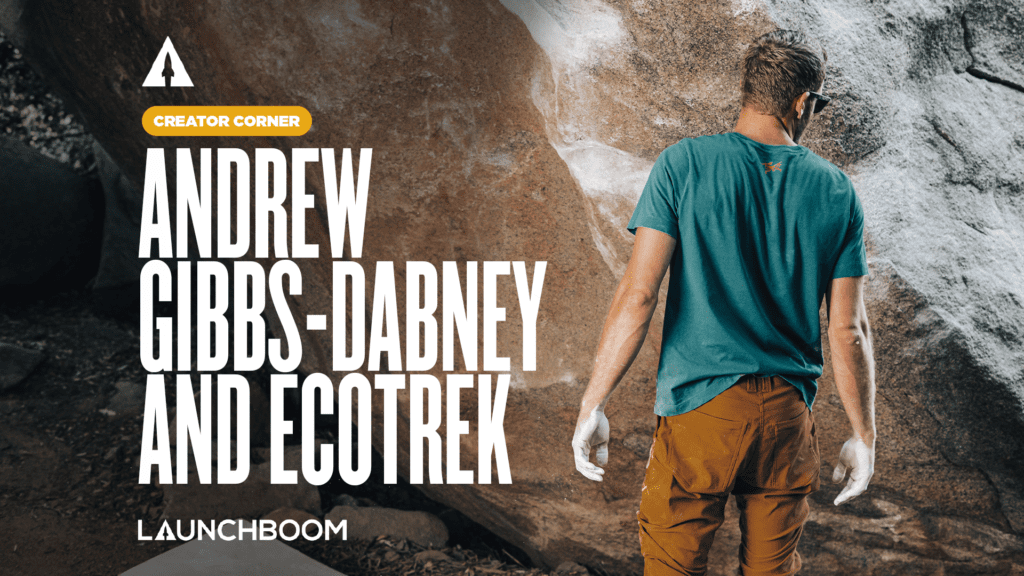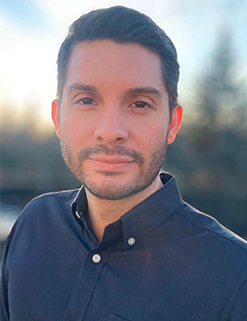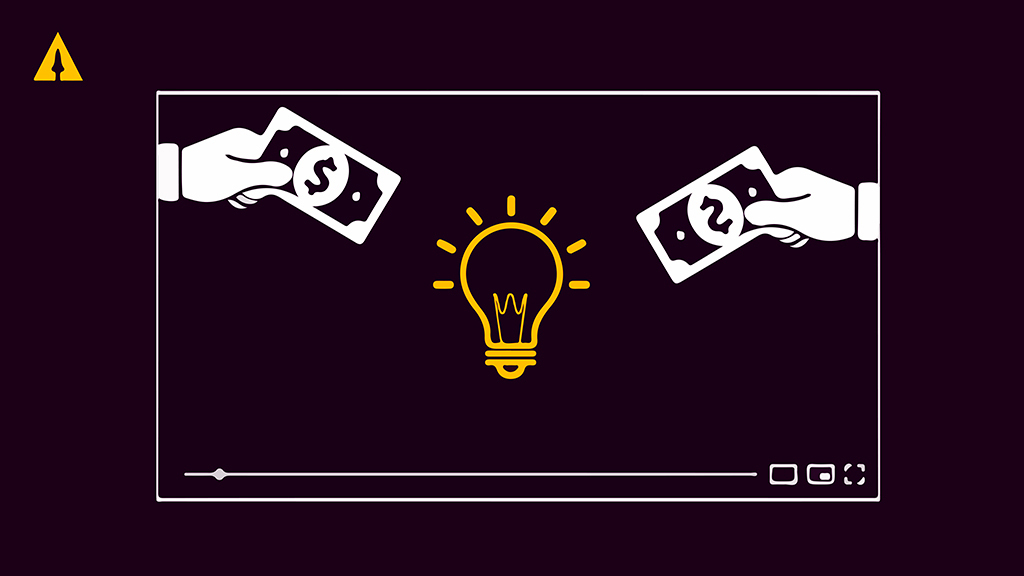
We sat down with Andrew Gibbs-Dabney from LIVSN to talk about their recent Kickstarter launch, the EcoTrek Trail Pants. LIVSN is a company devoted to producing high-quality, long-lasting products that people truly love, with the goal of reducing consumer waste. Their new pants are made for outdoor living, and the material is crafted from recycled ocean buoys. Read the interview below to learn about why Andrew chose to work with an agency like LaunchBoom, what inspired the EcoTrek pants, and where he’d like to travel with his EcoTreks in the future!
LaunchBoom: What have you crowdfunded before, and what prompted you to work with us this time around?
Andrew Gibbs-Dabney: We have done two previous Kickstarters as a brand. The first one was for two products: the Flex Canvas Pants and our Hi Wool Fleece. That launched us off the ground. The second campaign was for the second version of those Flex Canvas Pants from that first campaign. We were able to get feedback from our customers and improved them to make them more sustainable. EcoTrek was a new product. We had very lofty goals for what we wanted to do with this launch.
I found LaunchBoom by researching some of the most funded campaigns and outdoor apparel and looking at who their marketing partners were. LaunchBoom came up and after some more research, I reached out and found you.
LB: You had lofty goals that succeeded!
AGD: Yeah, it’s really amazing to see the half-million dollar mark.
LB: How has working with an agency like LaunchBoom changed the way you approach launching your products?
AGD: Working with LaunchBoom made the setup and pre-launch process much more streamlined and less stressful on our end. In the past, while we had worked with live campaign agencies, we’d never worked with anybody on the front side. I had been the one building all the digital assets, building the campaign page, making everything on the front end. Working with LaunchBoom on this one took a lot of the pressure off of the pre-launch, audience building, and campaign building itself. And that was really great.
Opening that up allowed us to really concentrate on what we do best, which is talking about our brand and building our product and making plans. Our plan is to launch one product per year via crowdfunding and a limited amount of products per year outside of that. We’ll pick one special product every year and launch it via Kickstarter. And that way, we’re always a part of that community, we’re able to take our customers that have come from our first campaign to our second one to our third one along for each progressive launch. We can be part of this crowdfunding ecosystem that helped us legitimately kickstart our company.
LB: Were you able to track whether or not you had return customers from previous campaigns?
AGD: I don’t have the exact number yet, but yes, we did pull out a lot of our previous customers. Our email list brought in about a quarter of our first day sales, which was over $100,000.
Anecdotally, we know just from comments and emails and people saying, “Hey, do these fit like your first ones?” We got a lot of questions in the comments, which say a lot of those people know our product, they know how our pants fit. So they just wanted to know, you know, are these the same?
LB: When did you have the idea for EcoTrek pants?
AGD: These pants have pretty much been the result of customer feedback. Our first pants are the Flex Canvas Pants, and they are predominantly cotton. They’re a blend of organic cotton and recycled polyester, and the majority is cotton, which makes them a very tough, durable, natural-feeling comfortable pant, but it does leave one shortfall. When it rains, cotton holds water and doesn’t dry out quickly. Our customers–and myself–being outdoorspeople said, “Hey, you know, I love these pants. I wear them legitimately every day. But when I go on a long hike, or I want something to wear outside when the weather might turn… We need something more, a fully synthetic pair.”
We started to work on the fabric first. Because we already had the silhouette, the fit, and a lot of the features that we were going to transfer from our current pants to these, we wanted to have a follow-up fabric that was going to be every bit as comfortable, high-performance, and good-looking aesthetically as our first fabric. We went out on a search. And ever since we moved to a sustainable blend for our Flex Canvas, we made a rule that everything that we did going forward was going to have to be a sustainable fabric.
So you’re looking for all these qualities, but under this big umbrella, it needs to be a recycled fabric. We found a mill that was doing a really cool thing where they were turning recycled ocean buoys into nylon fabric. It turned out that it had all of those qualities that we wanted. It had a nice drape, it was quick drying, stretchy, had water resistance, and it wasn’t shiny, which is a problem sometimes with technical fabrics. Then it had this really great sustainability story of recovering ocean waste and turning it into a new product.
LB: What did the prototype development process look like for these pants, especially with the new material that you used?
AGD: We were able to skip a few steps, already having the fit and a lot of the construction details nailed down from our previous pants. It was mainly around the fabric and adding a few new features. So the very first thing we did was just take our existing pants and make them with this new fabric. Our first prototype actually came in unwearable because the sampling room sewed it on the wrong bias, so it stretched two ways but not four ways. They sewed it where it stretched up and down. I got it and I was like, “Well, this feels awful.” I quickly figured out what was going on and we just had another sample turned out really fast, and the fabric was great.
It was white undyed fabric, so it looked like I was wearing tight ski pants or something. [At that point,] you don’t look for color, you look for feel. Once that’s done, we go ahead and order it in sample yardage in our actual colors, so that was the next decision. What colors are we going to make it in? So we made it in a caramel.
From there on, we started working with a few different designs for waist closure and expanded pocket sizing because those were the two things we wanted to put on these that were different: the ability to tighten your waist without a belt, and the ability to carry a phone or notebook in your back pocket. We wanted to do both of those things without adding much weight and without really being noticeable from the outside. We went through buckle clasp closures, some cinch and velcro closures, and we actually ended up with a drawstring inside the waistband that was just a really high-quality string with a good end on it and welded openings. The lowest tech, lightest weight, never-gonna-break solution was what we chose.
We went through all different pocket designs on the leg and ended up just taking our knife pocket that’s already there, making it bigger, and putting a zipper on top. So we do that a lot. We test a lot of complicated design elements and then we end up going usually with what’s the most simple, because usually the most simple design is the cleanest-looking and lasts the longest time.
LB: Right! No sense reinventing the wheel if you already have some of these elements. Did having knowledge from your previous pants shorten your development time for your prototype?
AGD: We got to spend more time on the details as opposed to the big things. And you know, when you develop a product from scratch, if you already have your factory, that’s big. But developing your product from scratch takes a long time and a lot of that, at least for us, goes into fit. Starting with a fit mark, with a pattern that works, allowed us to get 70% through the development process before we even started.
And then, like I said, knowing that we had a factory ready that knows how to make our pants to our quality standards, that saves a lot of time and also a lot of stress.
LB: Who tried on the first pair? What was it like? What color were they, after that all-white pair with the wrong stretch?
AGD: That was me again. They were caramel, and the experience was great. I immediately knew they were going to be awesome. I wore them that whole day, the whole next day. I went for a bike ride. That’s the pair that I really tested, because I couldn’t really test that first pair because they wouldn’t stretch the right way. So that was a great experience.
LB: Aside from biking, what other sports or activities did you do to test them out?
AGD: Honestly, on that first time, I did a bunch of yard work. I had an empty lot next to my house that was full of brush and I wanted to clear it out because there’s a creek down there and you could see it. So the first thing I did was, I went out there, cleared a bunch of brush, and wore them outside working in the yard all day. Over time, I ended up doing almost everything. I climbed in them, I hiked in them, I camped in them, road tripped, and I rode a lot of bikes. I just lounge around in them. But that first day was yard work.
LB: Part of the attraction for your pants is that they’re durable for outdoor adventures. Where did you test them out when you did the hiking, the camping, the climbing, the biking?
AGD: Luckily, “within reach” for us includes a lot of really great places to go. We went basically all through the Ozark Mountains on a four-day photoshoot-slash-big wear test, and we brought six pairs of pants. I was wearing them, all of our photo team was wearing them, so that’s three more guys, and then we brought a climber and a mountain biker. We went to Horseshoe Canyon Ranch here locally and went climbing all day. We went to another spot deeper in the woods. And then we went mountain biking and got a guy that was really good to do some kind of terrifying stunts in the pants. We camped and we overlanded. We drove basically through some of the roughest roads in Arkansas and drove around in them and just basically were outside for four days in varying weather.
LB: The photography that you did during those four days… was that a lot of the photography that ended up in the campaign or was that more internal?
AGD: I’d say 80% of the video came from that shoot. [LaunchBoom] did a photoshoot as part of our onboarding process, and there was climbing and some cycling and some urban stuff in there and it was really good. We went and shot video on location with some of our friends in our video team, and so that naturally ended up being most of the footage that you saw. It was very well-complemented with a lot of the clips that y’all were able to get from out west. Which is cool too, because you have varying topography and buildings, different kinds of things, so it gets a little bit more interest.
I’d say on the video, about 80% of it came from our home area, and the campaign page itself is about half and half between our own produced images and what LaunchBoom produced. You can tell, your models look like models… our guys look like our friends.
LB: There’s no accounting for models!
AGD: I didn’t mean that in a bad way! They’re just the ruggedly handsome guys, and the naturally handsome guys are our guys.
LB: I love that the photography and the video were a mix of all the different topographies. It really was able to show off all the places you could take the pants.
AGD: Our very first Kickstarter video, we went and shot in Colorado and we did it over five days. We started in Fort Collins, up into the mountains and a high pass camp there. We went deep into a valley, shot there, we went to kind of an open plains river and shot fly fishing there. Then we went to Great Sand Dunes National Park and shot in there. The idea for that trip was to just hit everything… we got plains, we got urban, we got mountain pass, we got valleys, we got big open rivers, and then we got desert all in one shoot, which was pretty cool.
LB: What did you learn about the manufacturing process from your first pants that you brought forward into the EcoTrek pants?
AGD: A lot, really. I’d say the biggest learnings we gathered from our first production runs have been around fit and fit consistency and controlling that with our manufacturer. We haven’t really ever had a quality issue. Pants don’t really fall apart outside of the very rare case. But between production rounds, we have had fit variations. We’ve done a lot of feedback gathering from our customers, and bringing that back to our factory.
On this particular run, since we can’t be there this time, we have an independent auditor that is there through production. He’s measuring and checking every pair of pants or, you know, a certain sampling of pants as they come off the line. He does not work for the factory; he works for us. So we’re there to make sure that everything comes off spec. That’s awesome. That’s probably the biggest thing.
We’ve been able to do more with scale from our first run to now because, this will be, like, our sixth production run of pants at this factory. We’ve been able to do things like get the buttons color-matched, get the zippers kind of custom… things that you couldn’t do when you’re making 600 pairs of pants that you can do when you’re making a lot more.
That’s a big part of our design philosophy is to constantly be iterating and making the product a little bit better every time we go to production. You always learn something. It’s very hard to make a perfect product on the first try. You’re gonna hear from your customers, and you’re gonna notice things and you can make it a little better every time.
LB: That’s part of the beauty of campaigning and building your brand, being able to improve on it! You mentioned that your plans down the road were to do one campaign per year and a few other products. What else do you see for the brand going forward?
AGD: We plan to do almost all of that with the addition of traditional retail as well. So our goal is not to be direct-to-consumer only, not to be crowdfunding only, but to be a brand at the tip of people’s tongues when they think “outdoor apparel” in all facets. One of our design philosophies or brand values is to do things slowly and intentionally so that we can iterate fast and build high-quality products. And so over the coming years, we plan to release anywhere from really three to five products every year that are very well-vetted, and add to our collections each time we do that. We’re not taking anything out. Everything that we release, we’re taking a long time to do it, because we’re not going to remove it. We want that product to be part of our catalog ongoing. So we will slowly over time build up a full collection of outdoor apparel, both for men and women.
LB: One more question for you! What are three outdoor places that you’re most excited to visit with your pants in the future?
AGD: Well, one of the places I’m most excited to spend some time at is in Oregon. I’ve never actually been to Oregon, which is weird. I’ve been everywhere around there, but I’ve never actually been. I’m excited to come spend some time up there and go skiing and go mountain biking.
Number two, I have a long-term goal to do a trip by vehicle from Alaska to Argentina. That’s a long one and one that requires a lot of time, but I would like to do that.
Number three… I really want to go see the Alps. I want to explore the Alps.
Thanks again to Andrew for sitting down with us! You can check LIVSN out here, and if you want to work with LaunchBoom, click here to apply.




